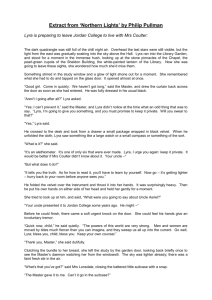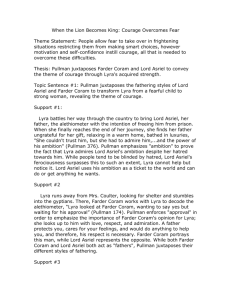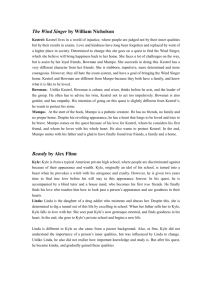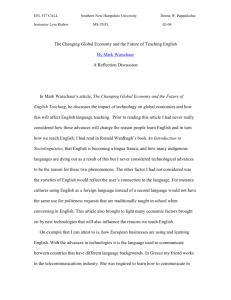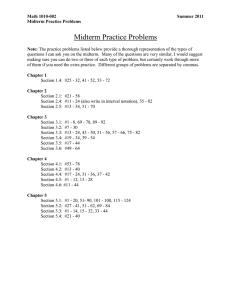9.00 Introduction to Psychology The Golden Compass points to the Midterm
advertisement
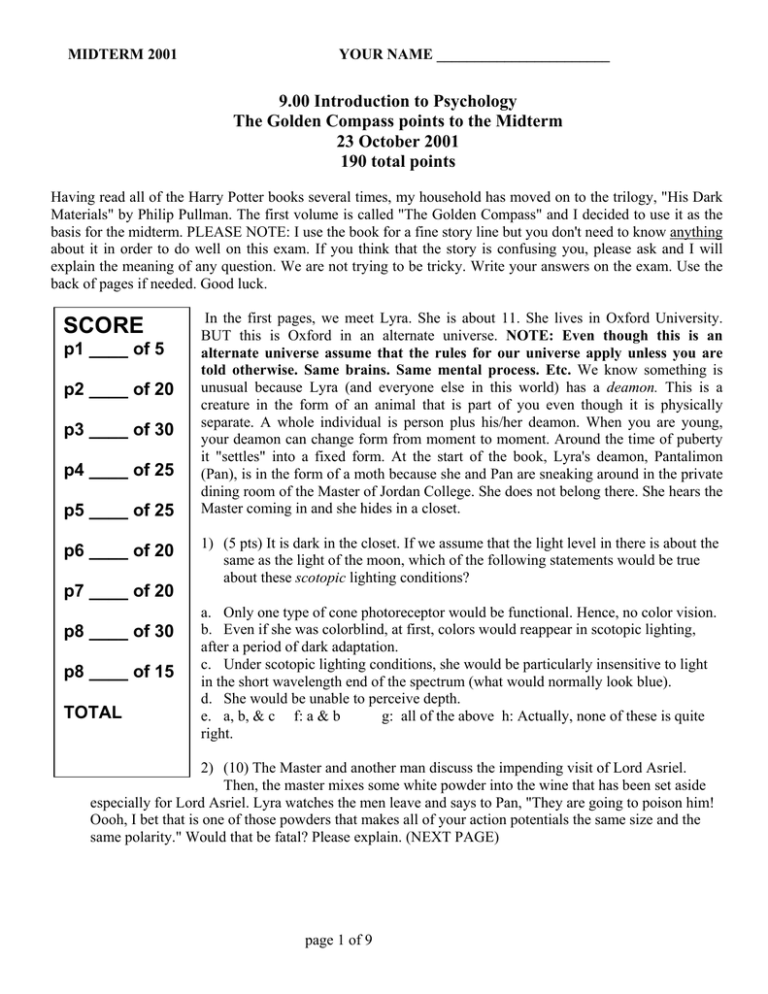
MIDTERM 2001 YOUR NAME _______________________ 9.00 Introduction to Psychology The Golden Compass points to the Midterm 23 October 2001 190 total points Having read all of the Harry Potter books several times, my household has moved on to the trilogy, "His Dark Materials" by Philip Pullman. The first volume is called "The Golden Compass" and I decided to use it as the basis for the midterm. PLEASE NOTE: I use the book for a fine story line but you don't need to know anything about it in order to do well on this exam. If you think that the story is confusing you, please ask and I will explain the meaning of any question. We are not trying to be tricky. Write your answers on the exam. Use the back of pages if needed. Good luck. SCORE p1 ____ of 5 p2 ____ of 20 p3 ____ of 30 p4 ____ of 25 p5 ____ of 25 p6 ____ of 20 p7 ____ of 20 p8 ____ of 30 p8 ____ of 15 TOTAL In the first pages, we meet Lyra. She is about 11. She lives in Oxford University. BUT this is Oxford in an alternate universe. NOTE: Even though this is an alternate universe assume that the rules for our universe apply unless you are told otherwise. Same brains. Same mental process. Etc. We know something is unusual because Lyra (and everyone else in this world) has a deamon. This is a creature in the form of an animal that is part of you even though it is physically separate. A whole individual is person plus his/her deamon. When you are young, your deamon can change form from moment to moment. Around the time of puberty it "settles" into a fixed form. At the start of the book, Lyra's deamon, Pantalimon (Pan), is in the form of a moth because she and Pan are sneaking around in the private dining room of the Master of Jordan College. She does not belong there. She hears the Master coming in and she hides in a closet. 1) (5 pts) It is dark in the closet. If we assume that the light level in there is about the same as the light of the moon, which of the following statements would be true about these scotopic lighting conditions? a. Only one type of cone photoreceptor would be functional. Hence, no color vision. b. Even if she was colorblind, at first, colors would reappear in scotopic lighting, after a period of dark adaptation. c. Under scotopic lighting conditions, she would be particularly insensitive to light in the short wavelength end of the spectrum (what would normally look blue). d. She would be unable to perceive depth. e. a, b, & c f: a & b g: all of the above h: Actually, none of these is quite right. 2) (10) The Master and another man discuss the impending visit of Lord Asriel. Then, the master mixes some white powder into the wine that has been set aside especially for Lord Asriel. Lyra watches the men leave and says to Pan, "They are going to poison him! Oooh, I bet that is one of those powders that makes all of your action potentials the same size and the same polarity." Would that be fatal? Please explain. (NEXT PAGE) page 1 of 9 MIDTERM 2001 YOUR NAME _______________________ 3) (10) "Maybe", says Pan, "Or maybe it is a poison that kills you by shutting down Broca's and Wernicke's areas in the brain." "Nah", says Lyra, "That wouldn't kill you." What problems might you expect if these areas were inactivated? (7 points for a good general answer, 10 if you make it clear that you know the difference between the areas). 4) (30) Well, what are you going to do?" asks Pan, "Lord Asriel is your uncle, after all." Before she can answer, Lord Asriel comes in. He is about to have a drink of wine when she cries out and he moves to the closet and drags her out. When he hears her story, he questions her closely. He is not sure if he should believe her. Some of the details seem wrong. She doesn't remember what the Master's daemon was doing, for example. Even if she thinks that she is being truthful, Asriel knows that there are many reasons why a memory might be inaccurate. Please describe three different examples of memory error or distortion. These should be VERY specific bits of evidence. They might be experimental examples. Don't just say "she might have forgotten" and don't just tell a story about when you forgot something. In each case, tell us three things - Describe the problem, phenomenon, or experiment. - Explain what might cause this sort of error (For example, "failure to encode new short term memories".) - Tell us whether this could be relevant in the present example (For example, this is unlikely because Alzheimer's disease does not occur in 11 yr olds ..... Now you can't use Alzheimer's...sorry). ANSWER ON NEXT PAGE page 2 of 9 MIDTERM 2001 YOUR NAME _______________________ ANSWER FOR QUESTION 4 Memory Problem #1: The Problem The Explanation Is it relevant to this situation? Memory Problem #2: The Problem The Explanation Is it relevant to this situation? Memory Problem #3: The Problem The Explanation Is it relevant to this situation? page 3 of 9 MIDTERM 2001 YOUR NAME _______________________ 5) (20) In any event, Asriel decides to believe Lyra and 'accidentally' spills the wine. When the Master comes in, Asriel apologizes. He explains that an incident in the north has made him "stereoblind". This means that he cannot use binocular disparity as a depth cue. Without stereopsis, he misjudged the three dimensional layout of the world and knocked over the glass. OK, he is making this up but is it a good lie? Could a lack of stereopsis contribute to an accident of this sort? Your answer should make mention of three other depth cues. Be sure it is clear that you know what the cues are. Do not just list them. Of course, your answer should also tell us why a lack of stereopsis would or would not make a difference here. NOTE: If you have no idea, describe four depth cues and hope for the best. 6) (5) Other Oxford scholars come in and, instead of a murder, a pleasant after-dinner conversation begins. One professor slides into a comfortable chair and says "Ah, the simple pleasures. Good food, good drink, a warm fire....." and another replies, "Strange to think that you seek these things just to produce activity in the correct part of the brain". "Oh, and where do you think that might be?" asks the first OK, it is a little simplistic to think that activity in one brain locus or the other is the definition of "pleasure" but, if you had to give an answer (and you do), which of these would make the most sense? a) hypothalamus b) thalamus c) gyral sulcus d) lateral ventricle e) cerebellum f) hippocampus h) Actually, this is really stupid (explain, briefly) page 4 of 9 d) occipital cortex g) the blue locus MIDTERM 2001 YOUR NAME _______________________ 7) (5) Another scholar speaks up: "You didn't come into the world with a hard-wired taste for fine wine and old leather chairs. You learned these things. Through repeated pairings of one with the other, you learned to associate these sophisticated stimuli with other, more basic stimuli." He is talking about learned associations between two stimuli. This would be called (Pick One....unless you want to pick two...but picking one if two are correct is better than picking two if only one is correct. a) operant conditioning d) air conditioning b) partial reinforcement e) classical conditioning c) Pavlovian conditioning f) positive conditioning 8) (10) Eventually, the gathering turns to the real purpose of Asriel's visit. He wishes to report on his journeys and experiments in the far north and to get the college to give him money for further investigations. He is investigating "Dust", the name that they have given to some strange particles that seem to come from the sky and settle on adult humans but not on children. The scholars are interested. After all, the Church (in this alternate universe) thinks that Dust may be the way that sin enters the world. The scholars are also thrifty. They don't want to spend money if they don't have to. To get the most money, Asriel plans to use framing: "A heuristic that affects the subjective desirability of an event by changing the standard of reference for judging the desirability of that event." (from the glossary of the Gleitman text) What does this mean? Explain the role of framing in decision making. Give an example. The example could be from the textbook or you can invent an example - maybe one that would work for Lord Asriel. 9) (10) In the discussion of funding a new expedition, many names of places in the north are mentioned. Trolesand, Nova Zemlya, Murmansk, Bolvanger, Svalbard, Tungusta, Yakutsk, Spitsbergen, Trondheim. Lyra has always been fascinated by the idea of the north, but the names are new and she wants to remember them all. She can't write them down so she will have to try to use a mnemonic technique. Please describe two techniques that she could use. Please tell us which one would work better in this case (and why). page 5 of 9 MIDTERM 2001 YOUR NAME _______________________ 10) (10) When everyone has left, Lord Asriel hauls Lyra out of the closet. He wants to ask her what she noticed. She wants to impress Lord Asriel with all the terms she learned about the north. Suppose she heard the place names in this order. Trolesand, Nova Zemlya, Murmansk, Bolvanger, Svalbard, Tungusta, Yakutsk, Spitsbergen, Trondheim. Which three names is she most likely to remember and why? 11) (5) Finally, exhausted, Lyra goes to bed. The next morning, she is supposed to have a lesson with one of the younger scholars who has been told to give her some education. She is not a willing pupil. He has to come and wake her up after 10 hours of solid sleep. She wakes and asserts that she has had a night of dreamless sleep. Which of the following is true? a) When she was awakened, it is most likely that she had been in a period of REM (rapid eye movement) sleep. b) Her claim of dreamless sleep is incorrect. She did dream. c) If her sleep was dreamless (or during the periods when her sleep was dreamless), her EEG (the massed electrical activity of her brain) would have been almost flat with just a little vegetative activity keep heart, lungs, etc. running. d) Sleeping for 10 hours is against the law, but it would be worth it. e) None of the above is likely to be true. 12) (5) Maybe Lyra is a reluctant pupil because her teacher is trying to get her to understand color vision. He takes a 470 nm light (It looks blue) and a 570 nm light (It looks yellow) and shines them both on a white wall at the same spot. What is the wavelength composition of the light, reflected from the wall to Lyra's eye? a) 470+570=1040nm b) nope, its the average (470 + 570) / 2 = 520 nm c) nope, its Pythagorean: sqrt((470*470)+(570*570)) = 739 nm d) nope, you have to divide that by 2 = 390 nm e) no, no....these lights, bounced off a "white" wall, will produce a broadband of all the visible wavelengths. f) nah, it will be just a mix of 470 and 570 nm. g) nope, this is opponent process territory so (570-470) = 100 nm h) Who knows? Not me! (1 pt for honesty) page 6 of 9 MIDTERM 2001 YOUR NAME _______________________ 13) (5) What would Lyra see in this case? What would the spot look like? a) white b) bluish-yellow c) green d) purple e) nothing, these wavelengths will cancel each other. f) Lyra will see the error of her ways and become a vision researcher. 14) (15) When class is over, Lyra runs off to find her best friend, Roger, the kitchen boy. They run up to the roof of the college to check on their crows. Roger, Lyra and their friends have been feeding different crows. They have made different rules for different crows. Buckbeak gets fed every time the college bell rings. It rings every 15 minutes. So, every 15 minutes the bird gets a bit of food. Fluffy gets fed when the bell rings....sometimes....On average, Fluffy gets food on every 5 bell rings. Norbert gets fed on average every 15 minutes. However, half the time this is when the bell rings and half the time, Norbert gets fed when the bell has not rung. All the birds have learned to come to the roof for food. Here is the problem, all day yesterday, the door to the roof was locked so the birds got no food yesterday. The children managed to get the door open this morning. That means many bells with no food. When the first bell of the morning rings, which bird is most likely to show up and why? A GOOD answer will be full of evidence that you know something about Instrumental Conditioning (pp128-139). All answers must say something about ALL THREE BIRDS. page 7 of 9 MIDTERM 2001 YOUR NAME _______________________ 15) (20) Lyra and Roger are also trying to teach the crows to talk. After all, daemons can talk and they have animal form and, in fact, the Master of Jordan College has a daemon in the form of a raven. For purposes of this discussion, let us suppose that these crows can vocalize like the best parrot and that they are as smart as chimpanzees (or gray parrots, who ever you think is smarter). How much will the children be able to teach these birds? For full credit, your answer must show that you understand the following four terms: phoneme, morpheme, semantics, and syntax. Your answer must also take a position on the question of whether language is unique to humans (in our world). You can argue either side of the issue. 16. (10) Lyra and Roger and the other children of the college routinely fight with the children from the town. In particular, the brick makers' children. The scholars in the college are opposed to this, of course. One scholar asks Lyra why she leads her friends into battle and she says that "All brick makers’ kids are bad". "Do you really believe that?" the scholar asks. "No, not really", Lyra replies, "I guess some of them are OK but I can't tell them apart." "Ah", says the scholar, "that is a problem in Signal Detection Theory. You are making errors in discriminating good bricklayers from bad ones. Or, to put it another way, when you encounter one of these children, you cannot tell if that child comes from the "good" distribution or the "bad" one. All you need to do is to shift your criterion toward the good, and you will stop labeling "good" children as "bad". What is the problem with this well-meaning advice? Assume that there really are "good" and "bad" children. Be sure your answer reveals some knowledge of signal detection theory page 8 of 9 YOUR NAME _______________________ 17. (5) The Scholar takes out a strange drawing (that looks a lot like the drawing on this page). He declares that this is a way of plotting the results of a person's choices. It could be choices about questions like "did I see that very dim light". It could be a choice between accepting someone as a friend or rejecting him as an enemy. As Lyra gets older, the scholar says that her wisdom will increase. He says that she, as an ignorant child, lives on the line marked "0" but as she gains wisdom, she will move to curve "1" and, with work to "2" or even "3". We are still in the realm of signal detection theory. What do the labels on the curve refer to? What we would call a set of RecieverOperatingCharacteristic (ROC) curves 100% 3 75% 2 1 50% H IT MIDTERM 2001 0 25% 0% 0% 25% 50% 75% 100% False Alarm a) d' - discriminability levels - The distance between signal and noise distributions. b) a' - levels of attention - The effect that maturity has on the ability to concentrate on a problem. c) (log) (1/error rate) d) log (accuracy) e) curvature in steradians f) hours until lunch 18. (10) Does the scholar's analogy make any sense? In what way would a shift from 0 to 1 to 2 to 3 represent and increase in wisdom? Does he have it backwards? Is this just complete nonsense? Well, this is barely the beginning of the book. Roger gets kidnapped. Lyra goes to London, but that doesn't really work out. There are murders and bears that wear armor...but I am out of time. Ah well, hope you did well. page 9 of 9
